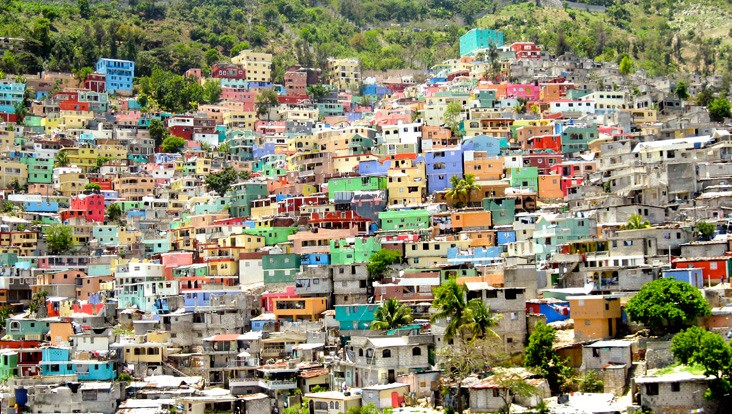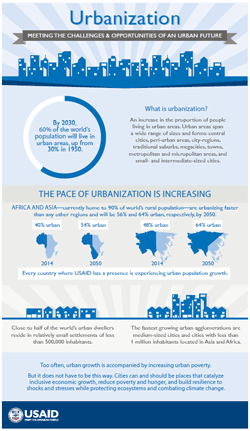- What We Do
- Agriculture and Food Security
- Democracy, Human Rights and Governance
- Economic Growth and Trade
- Education
- Ending Extreme Poverty
- Environment and Global Climate Change
- Global Climate Change
- Conserving Biodiversity and Forests
- Sustainable Urbanization for Global Progress and Security
- Securing Land Tenure and Property Rights for Stability and Prosperity
- Sustainable Land Management
- Environmental Impact Assessment
- Knowledge Management for Environment and Natural Resources
- Sustainable Tourism
- Earth Day
- Gender Equality and Women's Empowerment
- Global Health
- Water and Sanitation
- Working in Crises and Conflict
- U.S. Global Development Lab

Urbanization Infographic ![]() (pdf - 741k)
(pdf - 741k)
OVERVIEW
Rapid urbanization is today’s defining development trend. When USAID was founded in 1961, roughly 34 percent of the world’s population lived in urban areas. By 2030, that figure will rise to over 60 percent as cities and towns become home to more than 1.4 billion additional people. Nearly all of this growth and movement will take place within the developing world, much of it in fragile states.
Ensuring that urbanization in the developing world happens sustainably is an urgent priority as cities’ populations and areas are growing faster than the ability of national and local governments to plan for, build, and manage these changes. Poorly managed and chaotic urban development can undermine economic growth and business opportunities and threaten security through increased crime, violence, and extremism. Conversely, well-managed cities can serve as powerful engines of economic opportunity, innovation, and progress.
Helping cities prepare for and manage their growth and development is essential for:
-
Enabling Business Investment, Economic Growth, and Employment Opportunities: Cities are the primary engines of global economic activity, accounting for 70 percent of world’s GDP. As their populations continue to grow, so too can cities’ potential for job creation, trade, business opportunity, and investment. Vibrant urban markets also create a conducive environment for entrepreneurial innovation and generate expanded rural economic activity. But, realizing this potential will require: improving and streamlining regulations, laws, and policies; fostering markets and public-private collaboration; improving local governance, political stability, and fiscal sustainability; supporting municipal resilience and self-reliance; and improving transportation and telecommunications systems, physical infrastructure, and the delivery of essential services like electricity, sanitation, and education.
-
Promoting Stability and Preventing Violence, Crime, and Extremism: Fragility and instability are often driven by weak public safety and justice institutions, high youth unemployment, and an inability to meet citizens’ basic needs and rights, including housing, jobs, and essential political freedoms. An estimated 1 billion people, many of them youth, currently live in urban slums. By 2030, youth will make up 60 percent of urban populations. In many developing countries, unemployment rates for urban youth stand at over 50 percent. Youth are particularly at risk of unemployment because they lack prior job experience and links to professional networks and contacts, especially if they are recent migrants as this subset of the population is often estranged from their traditional family structures and support systems. Lack of opportunity and high rates of unemployment, inequality, and marginalization among urban youth constitute one of the greatest global security challenges.
Among other critical issues, sustainable urbanization is also essential for:
-
Strengthening resilience to respond and adapt to disasters, economic shocks, and extreme weather,
-
Improving global health and reducing the spread of infectious diseases,
-
Improving domestic resource mobilization, fiscal self-reliance, and government accountability,
-
Increasing women’s economic empowerment and access to services and reducing gender-based violence, and
-
Improving agricultural development and food security by strengthening rural-urban linkages.
OUR WORK
USAID takes a systems-based, holistic approach to sustainable urban development that integrates food security, economic growth, health, education, climate change, and resilience programming in a context of urbanization.
We achieve this by:
-
Building partnerships that support locally-led development at the municipal and national government levels,
-
Supporting legal, policy, and institutional reforms and stakeholder capacity building,
-
Reducing costs and improving efficiencies through partnerships and innovation,
-
Creating knowledge through scientific research and geospatial analysis to identify and disseminate emerging trends, evidence, and best practice, and
-
Providing technical assistance to address complex challenges that threaten stability or security and pose barriers to equitable economic growth.








Comment
Make a general inquiry or suggest an improvement.